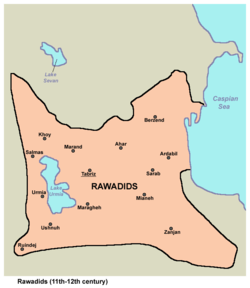Rawadid dynasty
Rawwadid or Ravvadid (also Revend or Revendi) or Banū Rawwād (Arabic: بنو روَّاد) (955–1071), was a Muslim ruling family centered in historic Azerbaijan (also known as Iranian Azerbaijan) between the late 8th and early 13th centuries.[1]
Rawadid dynasty | |||||||||||
|---|---|---|---|---|---|---|---|---|---|---|---|
| 955–1071 | |||||||||||
 Rawadids in the XI and XII centuries | |||||||||||
| Capital | Tabriz | ||||||||||
| Religion | Sunni Islam | ||||||||||
| Government | Emirate | ||||||||||
| History | |||||||||||
• Established | 955 | ||||||||||
• Disestablished | 1071 | ||||||||||
| |||||||||||
 |
|
|
Modern history
|
Originally of Azdi Arab descent,[2] the Rawadids ruled Tabriz and northeastern Azerbaijan in the late 8th and early 9th centuries.[1] The family became Kurdicized by the early 10th century and became centered on Tabriz and Maragheh.[3][4] In the second half of the 10th century and much of the 11th century, these Kurdicized descendants controlled much of Azerbaijan as well as parts of Armenia.[1]
History
Rawadids were originally from Arab ancestry, and arrived in the region in the mid 8th century,[5] but they had become Kurdicized by the early 10th century and began to use Kurdish forms like Mamlan for Muhammad and Ahmadil for Ahmad as their names[6][7][8] The Rawandid tribe moved into Kurdistan in the mid 8th century, and it was known as a Kurdish tribe by the tenth century.[9] In the second half of the 10th century and much of the 11th century, these Kurdicized descendants controlled much of Azerbaijan as well as parts of Armenia.[1]
The earliest form of the name is written "Rewend" in the Sharafnameh. According to Kasravi, Rawwadids conquered the lands of the Musafirid ruler Ibrahim I ibn Marzuban I, in Azarbaijan in 979. Wahsudan bin Mamlan is the best known Rawwadid ruler, and he is mentioned by Ibn Athir. The regions of Tabriz, Maragheh and the strongholds of Sahand mountain were in his possession. In 1029, he helped the Hadhbani Kurds in Maragheh to defeat the invading Oghuz Turkish tribes.
Wahsudan also sent an expedition to Ardebil under the command of his son Mamlan II. The ruler (sipahbod) of Moghan had to submit to the conqueror. Mamlan also built a fortress in Ardebil.[10]
Toghrul conquered the principality in 1054 CE, and he defeated the prince of Tabriz Wahsudan ibn Mamlan.[11] In 1071, when Alp Arslan returned from his campaign against the Byzantine Empire, he deposed Mamlan. Wahsudan's successor, Ahmad bin Wahsudan, lord of Maragheh, took part in the Muhammad Malik Shah's campaign against Syria in 1110 CE.[12] His full title was Ahmadil bin Ibrahim bin Wahsudan al-Rawwadi al-Kurdi.[13] Ahmadil fought again the crusaders during the First Crusade. Joscelin made a peace treaty with him during the siege of Tell Bashir (in present-day southern Turkey, south-east of Gaziantep). He was stabbed to death by the Ismailis in 1117 in Baghdad. His descendants continued to rule Maragheh and Tabriz as Atabakane Maragha until the Mongol invasion in 1227.[14][15]
Rawadid Rulers
- Muhammad Ibn Husain (? – c. 951 ?)
- Husain I (955–988)
- Mamlan I (988–1000)
- Husain II (1000–1019)
- Vahsudan (Wahsudan) (1019–1054)
- Abu Nasr Mamlan II[16] (1054–1071)
- Ahmad bin Wahsudan (in Maragheh)(c.1100-1116)
See also
- List of Sunni Muslim dynasties
- List of Kurdish dynasties and countries
References
- Peacock 2017.
- The Encyclopaedia of Islam: MAH-MID
- V. Minorsky, A Mongol Decree of 720/1320 to the Family of Shaykh Zahid, Bulletin of the School of Oriental and African Studies, University of London, 1954, p.524
- Jamie Stokes, Encyclopedia of the Peoples of Africa and the Middle East, Volume 1, Infobase Publishing, 2009, ISBN 978-0-8160-7158-6, p. 382.
- Vladimir Minorsky, Prehistory of Saladin http://rbedrosian.com/Ref/Minorsky/vmpsal1.htm#124.
- C.E. Bosworth, The new Islamic dynasties, 389 pages, Columbia University Press, 1996, ISBN 9780231107143 (p.150)
- W.B. Fisher et al., The Cambridge History of Iran, 778 pp., Cambridge University Press, 1968, ISBN 9780521069366 (p.32)
- Bosworth, C.E. "Rawwādids". Encyclopaedia of Islam (2nd ed.). p. 469.
The Rawwadids (the form "Rawad" later becomes common in the sources) were originally of Azdi Arab stock, but gradually became assimilated to their environment in Adharbaydjan (and especially, the area around Tabriz) and became Kurdicised...
- Massoume Price, Iran's Diverse Peoples: A Reference Sourcebook, ABC-CLIO, 2005, ISBN 9781576079935, p. 43.
- V. Minorsky, A Mongol Decree of 720/1320 to the Family of Shaykh Zahid, Bulletin of the School of Oriental and African Studies, University of London, 1954, p.524
- P. Blaum, Diplomacy gone to seed: a history of Byzantine foreign relations, 1047-57 A.D., International Journal of Kurdish Studies, Jan. 2005, p.15
- Houtsma, Martijn Theodoor, ed. (1913–1936). "Kurds and Kurdistan". Encyclopaedia of Islam. 4 (1st ed.). Brill. ISBN 9004097902. OCLC 258059134.CS1 maint: date format (link) (see under Turkish Conquest)
- The Supreme Muslim Council: Islam Under the British Mandate for Palestine by Uri M. Kupferschmid
- P. Bearman, Th. Bianquis, C.E. Bosworth, E. van Donzel, W.P. Heinrichs (editors), Encyclopaedia of Islam (Second Edition), "Marāg̲h̲a", Brill Online.
- Minorsky, La Domination des Dailamites, presented in a Conference of the Societé des Etudes Iraniennes, Paris, 28 May 1931. Also see Minorsky, Daylam in the Encyclopaedia of Islam, 1962, pp. 189–94
- The Cambridge History of Iran, Band 4 by R. N. Frye
Sources
- Peacock, Andrew (2017). "RAWWADIDS". Encyclopaedia Iranica.CS1 maint: ref=harv (link)
External links
- Rawwadids, Encyclopaedia of Islam.
- A Chronology of World Political History(801 - 1000 C.E.)(see Rawwadid)
- List of Rawadid Rulers